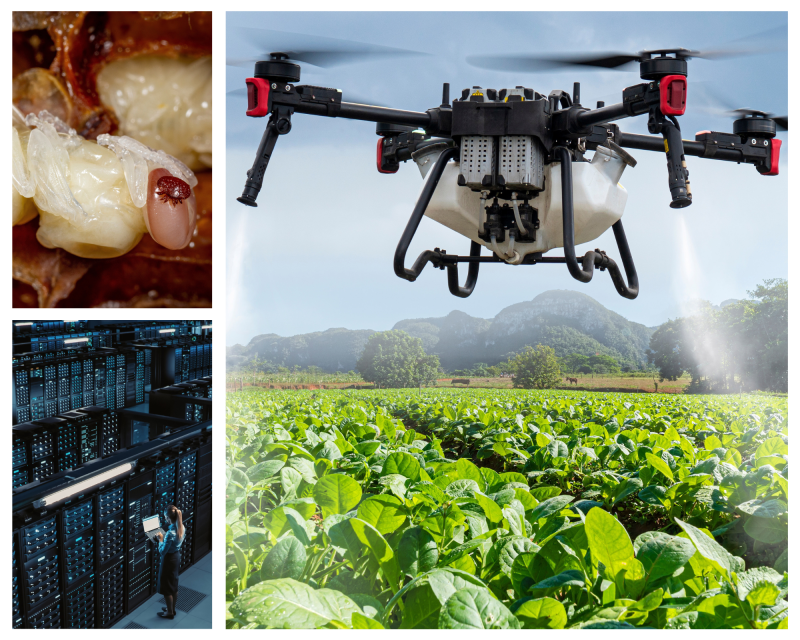Should I be worried when I see headlines suggesting that AI is “the most momentous technological innovation since the Industrial Revolution,” that it “will take our jobs,” “make us dumber,” or even “become the smartest lifeform on the planet”?
AI refers to technology that allows machines to learn and make decisions. I’m amazed at how much AI has already infiltrated our lives and how quickly popular AI agents (e.g. ChatGPT, CoPilot) can produce a document answering quite complex questions. I asked ChatGPT to tell me how AI helps gardeners…
AI helps gardeners by identifying plants and diagnosing diseases through image recognition apps. It monitors soil moisture, pH and weather conditions using smart sensors, recommending optimal watering and care. AI-driven irrigation systems conserve water by automatically adjusting schedules. Robotic tools like weeding robots remove unwanted plants without chemicals.
AI also assists in garden planning, suggesting plant combinations and layouts for better growth. Personalised virtual assistants offer timely advice on planting, pruning and pest control. By analysing data and predicting conditions, AI helps gardeners make informed decisions, boost yields and maintain healthier, more sustainable gardens with less effort.
Based on my considerable research, the following areas of AI influence are noteworthy for the potential impact on home gardeners.
We are undoubtedly seeing an increase in garden advertising, articles and general media being generated with the help of AI. It’s all too easy to undertake research quickly. However, these programs lack the nuances reflecting the experiences and personalities of human authors. They frequently come up with hilarious or questionable results that seem to reflect the poor quality or outdated horticultural advice on the internet. Plant or pest ID can be inconsistent, particularly in tropical and subtropical climates.
Incredible advances in AI technology, such as automatic mowers, tools and irrigation are reducing maintenance and labour costs. I’m waiting for the release of drones that will prune trees and clean my gutters! Concurrently however, young, experienced gardeners are becoming harder to find – so expect to pay higher labour rates!
Gardeners can plan and design their gardens using programs that design a layout, prepare planting set-outs, select plants and draw detailed plans with 3D imagery. AI will organise the delivery of the plants and locate local companies to plant and maintain them. Currently, these programs are unreliable, generic and somewhat uninspiring. They’re not going to be taking any jobs … just yet.

High labour costs debilitate the nursery industry, and the adoption of AI technology has resulted in a significant transformation. This includes monitoring water quality, irrigation, temperature, energy, plant growth, plant health and pest and disease incursions.
Autonomous drones and robots can undertake potting, pruning and spraying of plants. Technology manages inventory, including tracking and tracing of plants from propagation to sale and transportation to planting sites.
The upfront installation costs are daunting. Ongoing operational costs include investments in employee training and education, as well as the hiring of specialist consultants.
Larger nurseries that can invest heavily in AI technology will have a significant advantage, while smaller ones may struggle to compete on price points. Prepare yourself for the increased production of a reduced diversity of cheaper plants by fewer larger nurseries. The role of independent growers like Diggers will be more crucial, responding to this rapidly changing marketplace by continuing to grow and offer a wide range of plants and seeds for biodiversity.
Expect disruption. AI is rapidly replacing call centre, front-of-house and administrative roles, with workforce reductions of up to 80% already underway across many sectors. With an ageing and shrinking population, I wonder how will a reduced labour force sustain social welfare and retraining?
AI requires an increasing number of data centres to house computers that store and process information (“the cloud”). Data centre operations consume very high quantities of power and water and are associated with high carbon emissions. The massive investment in AI has resulted in rapid advances; however, AI models continue to run at significant losses. Many economists expect a sharp correction in the stock market and a collapse in future investment.
Gardeners can make the most of current technologies that help reduce maintenance costs in our gardens. If you haven’t tried it yet, have a go at doing some research using ChatGPT or CoPilot – just don’t believe everything you read!
